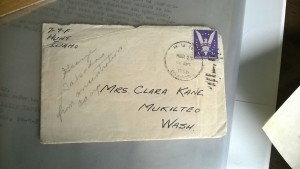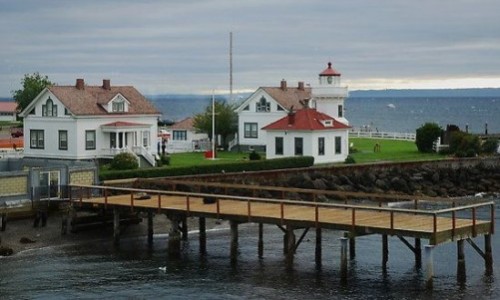The Mukilteo Historical Society archives can now be accessed online! As of December 2021, over 5,000 photo, object, archive and library items can be viewed through the MHS Online Collections Database curated using Past Perfect archive software. The digital archive is home to photos of Mukilteo’s early days, including historical photos of the light station and the city’s buildings, people, sites of interest. Electronic copies of photos are available for a small fee. (No fee for MHS Members and educational institutions.)
View information about our permanent exhibit on the lighthouse 100 Years of Light or our current exhibit The Way We Were. You can also read blog posts below about items in our archive or events in our past.
2019 Pioneer of the Year
This year’s Pioneer of the Year, Dan Hammer, has family roots in Mukilteo that go back 113 years! Dan will be honored at the MHS meeting on Thursday, August 8, at 7:00 pm at the Rosehill Community Center. Plan now to join Dan as he brings to life stories about growing up in Mukilteo, serving in the Coast Guard, and then serving Mukilteo at the Water Board for 43 years. As you continue reading this article, think of questions you might have for Dan.
Dan’s great grandparents, Floyd and Minnie Haynes, moved from Michigan to Whatcom County in 1904, and then in 1906 they settled in Mukilteo, as the new lighthouse was being completed. Their first home in Mukilteo was on Park Avenue close to Front Street and the old Dutcher Apartments. Later they lived near Pioneer Cemetery, in a home with a spacious garden and family orchard. They had five children, and one wonders if the kids found it scary to live so close to a graveyard.
Dan’s grandmother, Hazel Haynes, was actually born back in Michigan in 1901, but then at the age of five she came with her family to Mukilteo. She attended Rosehill School (the original building with the onion dome on top) and then went on to Everett High School.
In 1920, Hazel married Frank Saponaro, who had been born in Italy in 1894 and immigrated to New York in 1913. Along with many other immigrants, Frank served in the armed forces in WWI. Eventually he made his way to Mukilteo where he met Hazel while he worked for the Crown Lumber Company.
Frank and Hazel lived with their three children in a house on the Speedway. They are no longer with us, but the house still is! It was moved on wheels by the Saponaro family up to 7th and Washington, where it now serves (much-remodeled) as the home of Fred and Jennifer Baxter.
The youngest of the three Saponaro children was Jane, who was born in 1925. Jane attended Rosehill (the second Rosehill school building) and then Everett High. Jane married Ray Hammer, whose family had originally migrated from Norway to America.
Ray was raised in the Woodinville/Bothell area, served in the Merchant Marine in WWII, and then worked at the Tank Farm in Mukilteo. Jane and Ray and their two children, Dan and Janice, lived with Hazel Saponaro in the house at 7th and Washington. Then in the late 1950s, Ray built a house for his family at Tenth and Loveland. Dan has many memories of that home and his walks from it down the trail to Fifth Street.
Dan Hammer was born in 1947, an early addition to the postwar baby boom. He went to Fairmount Elementary for kindergarten, then Rosehill Elementary, Olympic View Junior High, and Cascade High School, graduating in 1966. Dan served in the Coast Guard, 1966–1970, much of the time on the Staten Island, a Seattle-based ice-breaker that operated in Antarctica and twice in the Arctic. He also served on lifeboat stations at Charleston, OR (Coos Bay) and Winchester Bay, OR (near Reedsport).
Following his Coast Guard service, Dan married his high school classmate, Mary Ann Kingsolver, in October, 1970. But they had not been high school sweethearts, because they only really met when sitting together at their graduation ceremony! Both were grateful that Dan’s Coast Guard service was based in Seattle, near enough for their romance to grow and blossom over the next four years.
Dan worked for the Mukilteo Water and Wastewater District for 43 years, retiring in 2013 as Water District Manager. When they were first married, Dan and Mary Ann lived in a townhouse off 80th Street. In 1974 they moved to their home on Goat Trail Road, where they still live. They have two sons, Morgan, born in 1976 and now living in Lynnwood, and Corbin, born in 1978 and now living in Everett. Dan and Mary Ann have four grandchildren.
These days Dan enjoys time with family, camping, fishing, gardening—and not having to explain why water bills have gone up! The Mukilteo Historical Society is pleased to celebrate Dan and his 113 years of family history in Mukilteo. It is especially fitting to note that one of the founding members of the Mukilteo Historical Society was Dan’s grand-mother, Hazel Haynes Saponaro.
Read the full the Summer 2019 MHS Newsletter here.
2017 Pioneer of the Year
Mukilteo’s Pioneer of the Year for 2017, Janice McCaulley Henry, has a lot of family! Janice’s mother, Hazel Riches McCaulley, was the tenth of twelve children. And Hazel’s mother, Mamie Gongia Riches, was the oldest of twelve children. So Janice has lots of relatives, many of whom lived in Mukilteo through the years.
Janice’s grandparents, Mamie and Ed-ward Riches, came from Wisconsin to settle in Western Washington in the early 1900s, coming to the Mukilteo area in 1906, the year in which the Mukilteo lighthouse began operation.
Then Mamie’s parents, Joseph and Mary Gongia (Janice’s great-grandparents), also decided to move from Wisconsin to Western Washing-ton. They sold their Wisconsin farm and, with their six youngest children, boarded the Great Northern for the four or five day train ride to the west coast.
Settling in Mukilteo, Joseph worked at the Crown Lumber Company. They had a large house near the beach and took in boarders. Later they moved to a house up the hill. They also lived in Seattle for a while, but after Joe died, Mary moved back to Mukilteo to live with family. Mary, who died in 1931, was known as “Grandma Gongia” to Mukilteo kids.
Mamie and Edward Riches, Janice’s grandparents, lived in the Edgewater area where they raised their twelve children. Edward was a chicken farmer and at one time had 1,000 chickens in two large coops. They also had a strawberry patch just past Edgewater. Edward owned the hall located near the Post Office on Park Avenue that was used as a skating arena and also for dances. Two of his sons, Claude and Walter, man-aged the hall. Claude and other members of his family played in a small band for dances.
Jan’s father, Ralph McCaulley, came to Mukilteo before 1920 and worked at the Crown Lumber Company. He and Hazel Riches were married in Everett; they lived in one of the small beach houses where Lighthouse Park is today. They had four children, and Janice, born in 1935, is the youngest.
Jan grew up in a house at 912 5th Street that Ralph had built using hand-split shakes and beams from the mill. Jan remembers fondly how her father loved music—when the ships docked in Mukilteo he liked to play his violin with the Filipinos playing mandolins and ukuleles. He also played piano in addition to the violin, an instrument Jan played in the Rosehill school orchestra.
After graduation from Rosehill school, Jan went on to Everett High. She re-members going to the beach where Alma Ek (“Ekie”) watched over all the kids as they swam there. Janice and her husband Larry Rise had three daughters: Leanne, Karen, and Lynda. Janice now has three grandchildren and one great- grandchild. Her second husband, Dean Henry, died in 2007.
Jan has lived in her house at 605 3rd street since 1960; the house is now one hundred years old. She enjoys doing art work, mostly using pastels. She also likes playing golf and gardening. Her garden was on the Mukilteo Garden and Quilt Tour in 2015.
Janice will be our guest at the MHS meeting on Thursday, August 10, sharing her memories of growing up in Mukilteo. She will be riding in the Lighthouse Festival parade with our MHS contingent on Saturday, September 9, and will be honored in a reception at the lighthouse at 3:00 pm that afternoon.
Why a lighthouse at Mukilteo?
Back in 1902, when Congress approved $22,000 for a lighthouse at Mukilteo, that was a lot of money. According to measuringworth.com, $22,000 back then would translate in 2016 to anything from $503,000 to $16,200,000, depending on how you calculate it! The House representatives must have been convinced that a lighthouse at Mukilteo would create real value in keeping the waterways safe and profitable.
Was Mukilteo a dangerous place for boats?
Unfortunately for human interest, there are no fables of shipwrecks or rescues in the Mukilteo area, as far as the Archive team knows. Continue reading “Why a lighthouse at Mukilteo?”
Letter from Internment Camp
 Imagine being taken from your home and sent to live in a camp in another state with several thousand people, taking with you only what you can carry. What would happen to your livelihood? What would happen to your property? What if you have people or animals who count on you?
Imagine being taken from your home and sent to live in a camp in another state with several thousand people, taking with you only what you can carry. What would happen to your livelihood? What would happen to your property? What if you have people or animals who count on you?
During World War II, this happened to a number of Mukilteo natives. They had been part of the Japanese community in the early 1900’s. Most had moved to other places by the 1940’s since Crown Lumber, the town’s primary employer, closed in 1930. However, many who had grown up in town and attended Rosehill School kept in touch with friends and mentors such as Clara Kane. Continue reading “Letter from Internment Camp”
